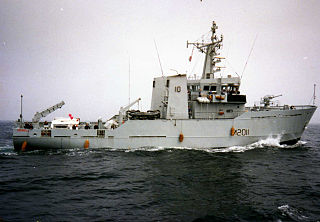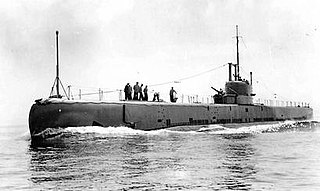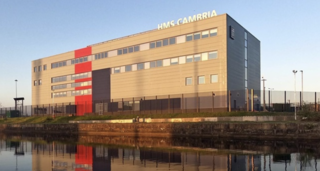
The Isles-class trawlers were a class of naval trawler used by the Royal Navy, Royal Canadian Navy and Royal New Zealand Navy during World War II.

The Ton class were coastal minesweepers built in the 1950s for the Royal Navy, but also used by other navies such as the South African Navy and the Royal Australian Navy. They were intended to meet the threat of seabed mines laid in shallow coastal waters, rivers, ports and harbours, a task for which the existing ocean-going minesweepers of the Algerine-class were not suited.

The River class was a class of minesweeper built for the British Royal Navy in the 1980s, designated Fleet Minesweepers (MSF).

The Racecourse-class minesweepers were 32 ships delivered to the Royal Navy during the First World War. They were built to two related designs as paddlewheel coastal minesweeping sloops under the Emergency War Programme. The vessels were reasonable sea-boats, but lost speed badly in a seaway when the paddle boxes tended to become choked with water. The class is also widely referred to as the Ascot class and Improved Ascot class.

The British Royal Navy operated large numbers of small Motor Minesweepers (MMS) during the Second World War, in two major classes: the first with 105 ft (32 m) hulls and the second with 126 ft (38 m) hulls. Intended to counter magnetic influence mines in coastal waters, they had wooden hulls.
Seven ships of the Royal Navy have been named HMS Venturer, with an eighth announced:

HMS Narwhal (N45) was one of the six ship class of Grampus-class mine-laying submarine of the Royal Navy. She was built by Vickers Armstrong, Barrow and launched 29 August 1935. She served in the Second World War in home waters. She was lost in the North Sea on 23 July 1940, probably sunk by German aircraft.

The Royal Naval Patrol Service (RNPS) was a branch of the Royal Navy active during both the First and Second World Wars. The RNPS operated many small auxiliary vessels such as naval trawlers for anti-submarine and minesweeping operations to protect coastal Britain and convoys.
A number of ships of the Royal Navy have borne the name Bombay, after the Indian city of Bombay, now Mumbai. Among them were:

A danlayer was a type of vessel assigned to minesweeping flotillas during and immediately after World War II. They were usually small trawlers, fitted for the purpose of laying dans. A dan is a marker buoy which consists of a long pole moored to the seabed and fitted to float vertically, usually with a coded flag at the top.

Naval trawlers are vessels built along the lines of a fishing trawler but fitted out for naval purposes; they were widely used during the First and Second World Wars. Some—known in the Royal Navy as "Admiralty trawlers"— were purpose-built to naval specifications, others adapted from civilian use. Fishing trawlers were particularly suited for many naval requirements because they were robust vessels designed to work heavy trawls in all types of weather, and had large clear working decks. A minesweeper could be created by replacing the trawl with a mine sweep. Adding depth charge racks on the deck, ASDIC sonar below, and a 3-inch (76 mm) or 4-inch (102 mm) gun in the bow equipped the trawler for anti-submarine duties.
Three ships of the Royal Navy have borne the name HMS St David, after Saint David, patron saint of Wales:
HMS Hodgeston was a Ton-class minesweeper which saw service with the Royal Navy during the Cold War. Built by Fleetlands Shipyard, she was launched on 6 April 1954 and broken up in 1988.
The Cybele class was a class of trimaran ships, constructed by the Royal Navy during World War II for the purpose of clearing minefields. Referred to as Mine Destructor Vessels, two ships of the class, HMS Cybele and HMS Cyrus were built in 1944; one was lost following D-Day, while the other survived the war only to be scrapped shortly thereafter.
HNoMS Thorodd was a Royal Norwegian Navy patrol ship and minesweeper that served through the Second World War, first during the Norwegian Campaign that followed the invasion of Norway in 1940, and then from exile in the United Kingdom. Thorodd was originally built as a steam escort trawler for the French Navy under the name Fleurus, before being sold to a Norwegian whaling firm who leased her to the Falkland Islands Government. SS Fleurus served as a commercial mail ship in the Falkland Islands Dependencies during the 1920s, and was the first vessel to carry paying tourists to Antarctica. Following the war, Thorodd was converted to a fishing trawler and sank in 1955.

HMS Cambria is the lead Royal Naval Reserve unit in Wales. It is based at Sully near the Welsh capital, Cardiff.
Junella was a fishing trawler, best known for her service with the Royal Navy during the Falklands War. She was built in 1975 for J Marr & Son, a Hull-based fishing company. On 11 April 1982 she was taken up from trade by the British government and commissioned into the Royal Navy. She was fitted with Second World War era minesweeping gear at Rosyth Dockyard, manned by Royal Navy sailors and allocated to the 11th Mine Countermeasures Squadron. She sailed on 26 April but was unable to commence sweeping until after the 14 June Argentine surrender. In the meantime she was utilised to transfer troops and stores between ships and landed special forces troops at San Carlos. Demining operations commenced on 21 June. Junella returned to the United Kingdom on 11 August, carrying a defused Argentine mine.

HMS Venturer is a Venturer-class minesweeper converted from the trawler Suffolk Harvester for the Royal Navy in 1978.
HMS St David was a Venturer-class minesweeper converted from the fishing trawler Suffolk Monarch for the Royal Navy in 1978.










